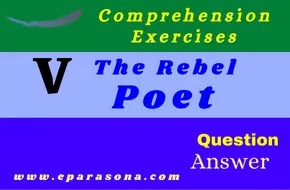The Rebel Poet | Textual Question and Answer | Grammar | প্রশ্ন ও উত্তর
Textual Exercise
Activity 1
Complete the following sentences:
(a) Pritam was to sing the song ‘Karar oi louha kopat’ on the Republic Day at his school.
(b) Nazrul was born in the village of Churulia near Asansol in the Burdwan district of undivided Bengal on 24th May, 1899.
(c) Burdwan district is in West Bengal now.
Activity 2
Answer the following questions:
(a) Was India independent when Nazrul was born?
Ans.> No, India was not independent when Nazrul was born. India was under the British rule then.
(b) Name some of the folk plays that young Nazrul had written.
Ans.> The names of some of the folk plays that young Nazrul had written are ‘Daata Karna’ and ‘Kabi Kalidas’.
(c) Who was Nazrul’s teacher?
Ans.> The revolutionary Nibaran Chandra Ghatak was Nazrul’s teacher.
(d) Who was Kumud Ranjan Mullick?
Ans.> Kumud Ranjan Mullick was a great poet and he was also the Headmaster of the school where Nazrul joined next.
Activity 3
Tick(√) the right answer:
(i) His poems inspired the youth (a) to fight the British (√) (b) to help the British (c) to talk to the British
(ii) A poem that he wrote was (a) Kheya Parer Tarani (√) (b) Prasna (c) Bodh
(iii) Nazrul was called (a) the fiery poet (b) the rebel poet (√) (c) the inspired poet
Activity 4
Write [T] for true and [F] for false statements in the given boxes:
(a) Nazrul was born when India was still under the British rule. [T]
(b) Nazrul was not attracted to folk theatre. [F]
(c) In school, Nazrul met the great poet Kumud Ranjan Mullick. [T]
(d) Nazrul served the Indian army under the British rule. [T]
(e) Nazrul fasted for thirty days. [F]
Activity 5
Fill in the chart information from the text:
Year | Event |
1910 | Nazrul met the revolutionary Nibaran Chandra Ghatak |
1920 | the regiment was disbanded |
1922 | Nazrul started a magazine ‘Dhumketu’ |
1923 | Nazrul was released from jail |
Activity 6
Answer the following question:
(a) Who inspired Nazrul to write poems?
Ans.> The great poet, Kumud Ranjan Mullick inspired Nazrul to write poems. Besides, he was also influenced by Rabindranath and the Persian poets like Hafez and Khaiyyam.
(b) Why did Nazrul have to leave the army?
Ans.> Nazrul had to leave the army because the army was disbanded in 1920.
(c) In which magazine was the poem Anadamoyeer Agamone published?
Ans.> The poem Anandamoyeer Agamone was published in the magazine, ‘Dhumketu’ in 1922.
(d) Why did Nazrul start fasting?
Ans.> Nazrul started fasting because it was his own way to voice his protest against the torture of the British.
Activity 7(a)
Underline the adverbs in the following sentences. Group them under ‘Adverb of manner’, Adverb of time’, Adverb of place’:
(1) Now I will go to school. [Adverb of time]
(2) He sat beside me.[Adverb of place]
(3) He will watch a play tomorrow.[Adverb of time]
(4) She eagerly waited for the result.[Adverb of manner]
(5) The train moved slowly out of the station.[Adverb of manner]
(6) We won the match yesterday.[Adverb of time]
(7) Come here.[Adverb of place]
(8) I shall gladly do it.[Adverb of manner]
Activity 7(b)
Let’s classify the adverbs ln the following chart:
Adverb of Time | Adverb of Manner | Adverb of Place |
now Tomorrow yesterday | eagerly Slowly gladly | beside Out here |
Activity 8
Let’s learn how to paint pots:
(i) At first a pot is bought.
(ii) Then it is washed with water.
(iii) Thereafter it is dried in the sun.
(iv) Next it is painted.
(v) At last polish is applied to make the surface shiny.
Now add linkers to show the process of painting pots. You may use the following linkers:
At first, then, at last, next, thereafter |
Activity 9
Write eight sentences about the childhood of Rabidranath Tagore. Here are some points:
Born on 8th May 1861 - did not enjoy formal schooling - was taught at home - mathematics teacher was Aghore Babu - used to play in the verandah - role - playing as a teacher - taught the railing bars as if they were students - conclusion
Childhood of Rabindranath Tagore
Rabindranath Tagore was born on May 7, 1861, in Kolkata. He did not enjoy formal schooling. He was taught at home. His mathematics teacher was Aghore Babu. He used to play in the verandah. He always took the role of a teacher in play. He taught the railing bars as if they were his students. In this way, little Rabi spent his childhood and memorable time.
Read More ->->->->
Gandhi, The Mahatma Click Here
A Feat On Feet Click Here
Phulmani's India Click Here
Memory in Marble Click Here
My School Days Click Here
The Clever Monkey Click Here
The Rebel Poet Click Here
Buildings to Remember Click Here
The Bird's Eye Click Here
A Great Social Reformer Click Here
The Finishing Point Click Here
Beyond Barriers Click Here
Grammar Click Here
Writing Click Here
Model Question Click Here
Do Practice this Story, Grammatical Questions, and Answers yourself. You will definitely score an excellent result.
Subscribe to and regularly Visit this Website www.eparasona.com for getting more updates and keep in touch with this Online Knowledge Hub.
This is an educational tutorial Website. On this Website, we write blogs that help students to gain information about different subjects. So, everyone and of course all the students who want to enhance their knowledge must subscribe to this Website to keep in touch with this Online Knowledge Hub.









0 Comments